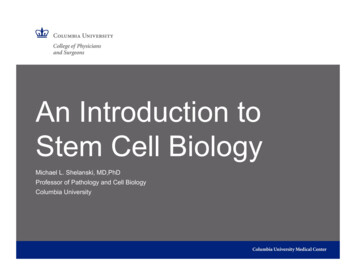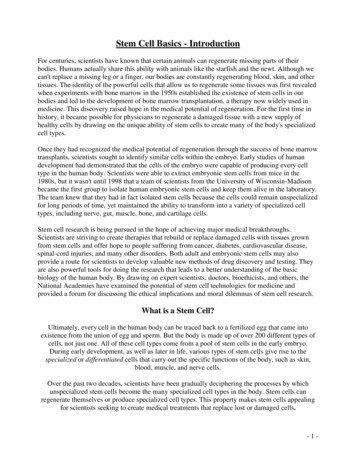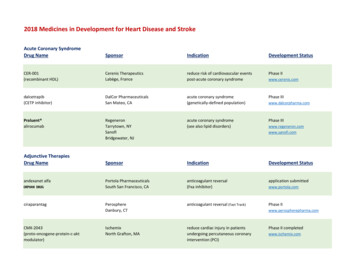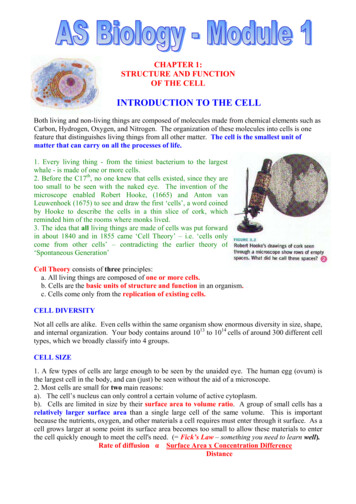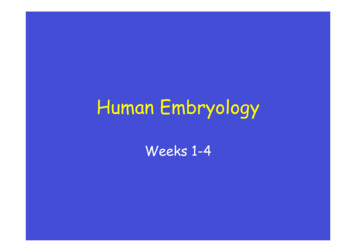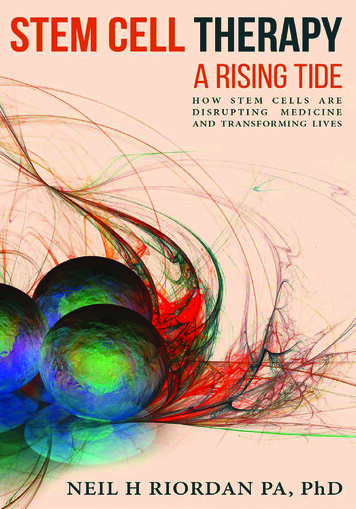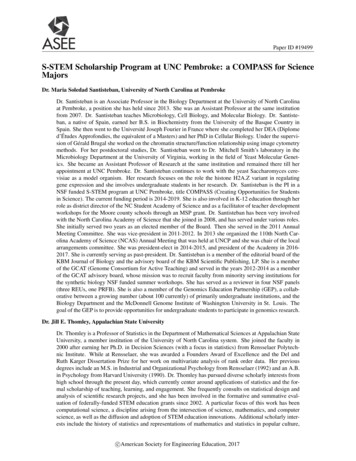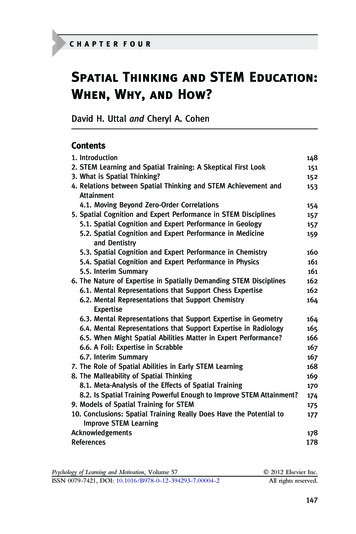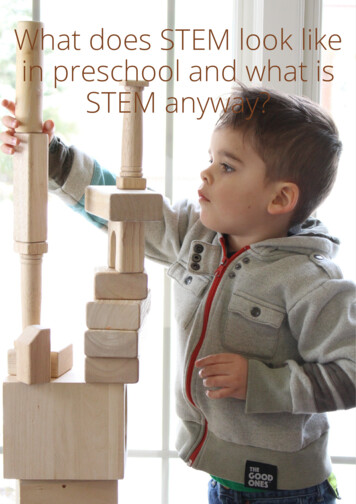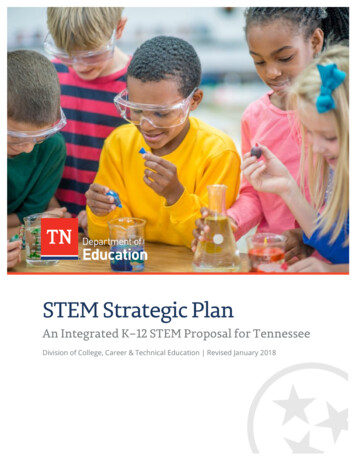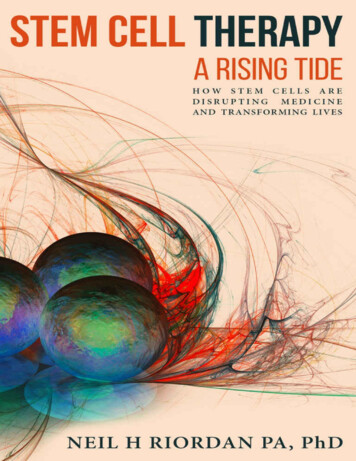
Transcription
Stem Cell Therapy: A Rising TideHow Stem Cells are Disrupting Medicine and Transforming LivesCopyright 2017 by Neil Riordan, PA, PhDAll rights .comNo part of this book may be used or reproduced in any manner whatsoever without writtenpermission from Neil Riordan, except as provided by the United States of Americacopyright law or in the case of brief quotations embodied in articles and reviews.This book is not intended as a substitute for the medical advice of physicians. Theinformation provided in this book is designed solely to provide helpful information on thesubjects discussed. The reader should regularly consult a physician in matters relating totheir health and particularly with respect to any symptoms that may require diagnosis ormedical attention. While all the stories in this book are true, some names and identifyingdetails have been changed to protect the privacy of the people involved.Layout design by www.iPublicidades.comIllustrations byBlake Swanson – Innercyte: Medical Art StudiosSteve Lewis – Blausen MedicalStem Cell Institute & Riordan-McKenna InstituteCovert design by n23artPrinted in the United States of America.First Printing: 2017ISBN: 978-0-9990453-1-2
TABLE OF CONTENTSForewordIntroductionCHAPTER ONE: The Seed Is Planted—Hope for Muscular DystrophyCHAPTER TWO: The Body’s Innate Healing Ability— Cancer SpelledBackwardsCHAPTER THREE: Redirecting the Immune System— Cancer ExposedCHAPTER FOUR: Getting Started with Stem CellsCHAPTER FIVE: Stem Cells in ActionArnold Caplan InterviewRobert Harari InterviewCHAPTER SIX: Spinal Cord Injury—The Ultimate RepairCHAPTER SEVEN: Multiple Sclerosis— Calming the Immune SystemBob Harman InterviewCHAPTER EIGHT: Heart Failure Turnarounds— A New ApproachCHAPTER NINE: Frailty of Aging—Reversing the InevitableCHAPTER TEN: Respiratory Disorders—A Fresh BreathCHAPTER ELEVEN: Arthritis—A New SolutionCHAPTER TWELVE: Biologics in Orthopedics— The Riordan McKennaInstituteCHAPTER THIRTEEN: Autism—Progress, Not RegressionCHAPTER FOURTEEN: Ulcerative Colitis— Autoimmunity in the GutCHAPTER FIFTEEN: Diabetes—A Paradigm Shift
CHAPTER SIXTEEN: Lupus—An Opportunity in Autoimmune HealthCHAPTER SEVENTEEN: Magic Juice—The Elixir of Life?CHAPTER EIGHTEEN: Lifestyle Choices— How to Protect Your HealthCHAPTER NINETEEN: Controversy and s
ForewordAs I read this book, I became very emotional. I had to go back about 28 yearsago when my wife and I sat in a doctor’s office and listened to a neurologistlist in grim detail how our beautiful three-year-old son Ryan would spend hisnext 20 years. The doctor told us there was nothing that they could do at thattime. He suggested that we do everything we could to keep Ryan active inorder to maintain the strength he had as long as possible. And hopefully inthe next 20 years they might find a cure for muscular dystrophy. Theprognosis changed our lives forever. It was a very painful time for all of us.As I continued to read about all of the patients who have been treated byDr. Riordan, I realized that we all had one thing in common: traditionalmedicine had given up on us. There was nothing that could be done. Our owngovernment, founded on the premise of life, liberty, and the pursuit ofhappiness, had evolved into overreaching bureaucracy that would attempt toprevent us from seeking lifesaving alternative treatments.But once again, we all had something else in common. We found a manwho was willing to do everything in his power to offer us options and give ushope for the future of our loved ones. Dr. Riordan has truly dedicated himselfto his profession as a medical pioneer. He has sacrificed everything he has togive those who have been told there are no options a fighting chance and realhope for the future.Dr. Riordan has never wavered in the face of scrutiny. It takes true courageto stand up to the often judgmental “traditional” medical community—thosewho act offended when you suggest that there might be a different way.Fortunately for all of us, Dr. Riordan had the foresight to look beyond thewalls of traditional medicine and fight the fight for us. I encourage you toread this book, and not just the chapters related to your condition. As a
whole, the book lays out Dr. Riordan’s courageous and successful journeythrough his stories and the stories of his patients.Thank you, Dr. Riordan, for all that you have done for us and our families.You truly are a hero!George Benton, Ryan’s father
IntroductionBY ARNOLD CAPLAN, PHDNeil Riordan, PhD, PA is a pioneer of the highest order, in some ways likeJohn Glenn or Neil Armstrong. Neil has ventured where the routes wereuncharted and the dangers huge. His rocket of cell therapy was launched on arickety platform filled with hopes and dreams, and powered by an engine ofmoney. This pioneer has hacked his way through the jungle of naysayers andhas produced miracles of enormous proportions. He has taken our scientificdreams and translated them into a high-caliber medical facility that does goodby offering exposure to cell therapy treatments that we working scientistsonly dream about.Although there are those in my professional realm who would say that Neilis a medical “cowboy” who “experiments” with human subjects, I would saythat he is providing access to therapies that are no more experimental thanone sees every single day in the surgical suites of major medical centers. Insuch situations, the surgeon is “forced” to improvise because of thecomplexity of the wound field. Such improvisation sometimes involves usingmaterials that are not approved but that the surgeon “feels” will work well inthe situation he faces. For example, human decellularized skin from deadpeople was approved for topical applications for ulcerated wounds in diabeticpatients. But these “membranes” are fabulous for closing abdominal surgicalwounds in hernia repair operations and have changed the way such closuresare done. This surgical improvision, originally performed by a “cowboy”surgeon, is now the standard of care. We move forward in medicine by theskill and insightful work of pioneers—some with IRB approval and some not.Riordan’s procedures with MSCs currently have IRB approvals.In a sense of transparency, let me say that I have accepted honoraria fromNeil Riordan and gifts of hotel rooms, meals, and, indeed, infusions of MSCs.These all have monetary value, but none influences my opinion. The
monetary success of Neil’s enterprises evoke jealousy in some entrepreneurs,but Neil’s continual reinvestment of money into his next medically successfulenterprise displays his true motives—the advancement of a medicallynecessary science despite great obstacles. The key to his success is in theenormously high quality of his facilities; the people, doctors, nurses,receptionist, PR team, etc. are all highly principled and care about thepatients they serve. These people care about what they do because Neilrecruits them for their skills and attitude. He does not discuss this in thisbook, but they are present on every page. He talks about Dr. Paz, but he doesnot tell you of his long medical experience and his reputation in the UnitedStates and in Panama for caring and experienced medical judgements. In allof Neil’s clinics, quality control labs, hotels for patients, and restaurantswhere they eat, the staff behind the scenes are dedicated to providing thehighest quality medical care possible. Some clinics and hospitals in theUnited States could take lessons from the Riordan gang. That said, the cellbased therapies Neil’s clinics provide have not all been approved and testedby double-blind, placebo control and rigorously monitored clinical trials,although such trials are currently underway. But, like innovative surgeons,these open-label uses have proven effective, as hopefully we will see inpublished peer-reviewed reports of his studies.Each chapter of this book recounts the personal stories of how Neil’sunwavering confidence that cell-based therapies with MSC preparations fromfat, marrow, or umbilical cords can make a medical difference. Neil mademedical tourism work, and what he has done is highly laudable, not onlybecause of the patients he has helped, but because of the laws that have beenwritten to support cell-based therapies in Panama. This book is not what Ipleaded with Neil to write, however. I have, for many years, begged him togive us outcome reports of his many patients: what they have as clinicalproblems, what they walk in with, and the longitudinal outcomes after thecell infusions. Hopefully these will be forthcoming, but they are not in thisbook. What is here in these pages is, none-the-less, amazing.
I first learned about Neil’s clinic in Costa Rica and thought his proceduresand therapies were brilliant. And these were crude compared to thosecurrently underway in Panama. The Panama GMP-production facilities, hisoffices and treatment rooms, and the products including MSCs fromumbilical tissue are of the highest quality. These are the vehicles and theplatform that allow him to write this treatise of the therapies they provide. Itis a shame that we have to fly to Panama to have access to these therapiesinstead of having them available in the United States. How long will it takefor such therapies to be available to the patients covered by Medicaid orMedicare instead of those from Beverly Hills or Long Island who can affordto travel to Panama?Almost daily I receive emails from people who want access to “stem cell”treatments. I tell them that I am just a PhD researcher and cannot suggest anavenue of treatment for medical issues. If you have this book in hand, readthe chapters. They are honest, open, and spellbinding. While Neil is not amedical doctor, his clinical experience as a physician assistant along with hisresearch background have prepared him for the serious medical issues forwhich Neil has organized cell therapy treatments, often with quite significantoutcomes. Neil is certainly a student of the medical arts and an expert usinginnovative treatments. I have talked to patients of Neil’s clinics and theirfamily members about their treatments; the stories told in this book are justthe tip of the iceberg. This is an interesting book and an interesting and gutsyjourney of Neil Riordan. His physician father would be proud to recognizeNeil’s passion and medical achievements.Arnold I. Caplan, PhDSkeletal Research CenterDepartment of BiologyCase Western Reserve University10600 Euclid AvenueCleveland, Ohio 44106January 15, 2017
Chapter OneTHE SEED IS PLANTED—HOPEFOR MUSCULAR DYSTROPHYGeorge Benton and I had been classmates since elementary school inWichita, Kansas, but we didn’t get really close until we became dads. MyChloe was born a week before the Bentons’ Ryan. We lived only a fewblocks from each other in the same neighborhood.Our families ended up spending so much time together that Chloe andRyan fast became playmates. Around the age of three, Ryan’s physicaldevelopment started to lag behind Chloe’s. We noticed he had trouble gettingup from the floor. He didn’t just jump up like the other kids. For him,standing up was a three-point movement that required him to steady his handon his knees to maneuver himself upright. And he couldn’t simply dash upthe stairs—Ryan had to take them one at a time.At first we thought Ryan was just a little clumsy, or maybe he wasn’t goingto be very physically active. But the Bentons’ friend, who was doing aresidency in orthopedics, told them Ryan had classic signs of musculardystrophy. When his diagnosis was confirmed, we all went into mourning.The diagnosis meant, at best, Ryan would live into his early twenties. It wasinconceivable to me, feeling how much I loved Chloe and all the hopes I hadfor her, that a life so tender and promising could be snapped off just as it wasbeginning to blossom.There is no cure for muscular dystrophy, of which Duchenne, the typeRyan has, is the worst form. People with Duchenne do not produce enoughdystrophin, a protein that helps maintain the integrity of the muscles. Without
it, the skeletal muscles break down first, and then, year by year, othermuscles and tissues begin to die off. Ryan’s body would eventually collapseon itself. It broke everyone’s heart to realize that this boy, with such a greatspirit and a huge appetite for life, probably wouldn’t be able to walk by thetime he was twelve, and that by the time he reached his twenties he’d mostlikely need a respirator. All I could think was, why can’t someone help Ryan?Although I didn’t realize it at the time, a seed was planted in my mind thatwould later grow into a strong passion for finding answers to some ofmedicine’s toughest questions.The Bentons handled this tragedy bravely. They became very involved inthe Muscular Dystrophy Association (MDA)—Ryan was even a poster childfor a while. Ryan traveled all over the state speaking to groups about hiscondition and raising money for research for a cure, which his doctors toldRyan’s parents would be realized within his lifetime. At home, the Bentonstried to give Ryan as normal a life as possible. He was in Boy Scouts, andthey even signed him up for tee-ball. He’d hit and another teammate wouldrun the bases for him. Ryan’s friends were the kind of young people who giveyou hope for the future: kind, caring, loyal, and true friends to Ryan nomatter what kind of a day he was having.Ryan was a brave boy, and he hid his condition well. In fact, until he wasseven, he didn’t even think he was different than his peers. But by that timethe effects of the disease became undeniable. His frailty began to show. Oneday Chloe flirtatiously shoved him while playing hoops, and he went flyingacross the yard. She didn’t realize how far her playful gesture would launchher friend. I’ll always remember the look of shock on her face.By the time he was eight, Ryan wore leg braces. Kids with Duchenne tendto walk on their toes to get better balance, but that shortens the muscles intheir ankles. The Bentons were on a mission to keep Ryan ambulatory as longas possible. He complained about having to wear long, uncomfortable legbraces when he went to sleep at night. They’d often find the braces removedand by the side of the bed in the morning. All the exercise—the swimming,physical therapy, and time on the treadmill—couldn’t postpone the
inevitable. By the time Ryan and Chloe were thirteen, when my family and Imoved to Arizona, Ryan was in a wheelchair full time. After our last visitwith Ryan as we were departing Wichita, I wondered what shape I’d find himin when we saw him again.In all of my later travels, which eventually led to working with adult stemcell therapies, Ryan was never far from my mind. When I marveled at thebeautiful, independent young lady Chloe was becoming, I’d think of theBentons and how different their life with Ryan was. After we left Wichita,George and his wife Sandra divorced and each remarried. I kept in touch withGeorge. Every time I saw medical research about any slim advance in thetreatment of muscular dystrophy, I’d forward it to him. When I visitedWichita, we’d see each other, and inevitably we’d talk about Ryan’scondition and how it was deteriorating. “Dad, I remember you told me they’dhave a cure,” Ryan said, referring to what the doctors told his dad when Ryanwas first diagnosed.“How do you answer that?” his dad pleaded with me.It wasn’t until I lived in Costa Rica, where I had established a medicallaboratory and clinic treating patients with stem cells, that I could finally bearfruit from the seed planted in my mind so many years before. My colleague atthe Stem Cell Institute, Fabio Solano, MD, said he wanted to treat a patientfrom Ireland who had muscular dystrophy.Our Irish patient had a less severe form of the disease, Becker’s musculardystrophy, which doesn’t appear until later in life. With Becker’s, the bodyproduces some, but not enough, dystrophin. Data from our own research, andthat of other scientists from around the world, showed that when adult stemcells are injected into muscle, they become part of the muscle and persistthere for a period of time. No one is certain exactly how long the stem cellsremain viable, but for at least a few months, some of the cells survive. Our
theory was that if the cells were from a healthy donor, they would producesome dystrophin. Even a little dystrophin could help.I had read of one case of a child diagnosed with Duchenne when he wasfourteen, more than a decade past the average onset of the condition. Whenhe was much younger, he’d received a bone marrow transplant for anothermalady, so his immune system and blood-forming system was essentially thatof someone else. The cells from that bone marrow cycled through his bodyand seeded the other cells, which helped to combat the onset of hisDuchenne. In fact, when he was diagnosed, he had one of the mildest cases ofDuchenne his doctors had ever seen. I thought some of the cells from hisbone marrow transplant must have produced muscle-fortifying dystrophin.After considering our Irish patient’s chances carefully, we decided to proceedwith treatment.As Dr. Solano and I reviewed the literature and talked about our Becker’scase, I thought, of course, of Ryan. Maybe we could do something with adultstem cells for him. If treatment went well with our Irish patient, perhaps theBentons would be willing to take a chance on treating Ryan.When our Irish patient came into the clinic, he reminded me of Gollum,J.R.R. Tolkien’s fictional character who lived underground, hunched overfrom years of obsessing over the precious golden ring he coveted. Our patientwas only in his thirties, but he was bent over and used a cane with a fourpronged base to walk. Dr. Solano and I decided to concentrate treatment onhis core muscles because he could barely hold himself upright. In order totreat our Irish patient effectively, Dr. Solano injected thirty-five vials into thisman’s muscles even though he was charged much less for the treatment. Itold Fabio, “Man, we’re going to go out of business!” This was very early onin our work, when each vial of stem cells cost us thousands of dollars toproduce. I’m thankful that technological advances since then have greatlyreduced that cost.A few months later our Irish patient walked fully upright into the clinic andsaid in a strong, clear voice, “I want to see Dr. Solano.” I couldn’t have beenhappier. And I thought, what good news this could be for Ryan.
At first, I didn’t know how to approach the Bentons to suggest that they trythis unconventional treatment. I didn’t want him to think I was pressuringhim or that I was trying to use our friendship to get business for my clinic. Igenuinely believed this treatment could help Ryan. A good friend of ourstalked to him about it and reported back that George was enthusiastic.At that point Ryan was twenty-two. His Duchenne muscular dystrophy hadfollowed the normal trajectory and Ryan’s body was falling apart. He hadmetal rods holding up his spine so his body weight wouldn’t crush hisinternal organs. They’d built a ramp at the front of the house so he could getin and out on his own in his wheelchair, but when he took the down slope toofast, his head would often flop onto his chest. He’d have to wait untilsomeone came along to pick up his head for him. The most worrisome forGeorge and Sandra were his lung infections. Four times a year he’d getbronchitis, which would always turn into pneumonia, and Ryan would end upin the hospital. At that point he weighed only 70 pounds. Sadly, his parentsknew it was only a matter of months before Ryan would die.The next time I was in Wichita I met with George, Sandra, and Sandra’ssecond husband Curt to discuss the treatment. Sandra was very concernedabout using donor stem cells to treat Ryan. Where would those stem cellscome from? I told her that we would use stem cells from donated umbilicalcords that underwent extensive testing, but she was still very uneasy. Formany years researchers felt similarly—injecting cells from someone else’sbody would surely trigger immediate rejection, they thought. But withumbilical cord cells, which are a type of immature cell that the immunesystem doesn’t recognize as foreign, this is simply not true. Afterconsiderable discussion, we decided to use stem cells cultured from Ryan’ssister Lauren’s menstrual blood. From that, we grew a culture of 200 millioncells. Three months later George and Ryan, along with Ryan’s best friendClint, flew to Costa Rica for the first treatment.
When they brought Ryan in for his shots, I was stunned by how much hiscondition had deteriorated. His skeleton frame had almost no muscle fibers.George and Clint transferred him from his wheelchair to the treatment bed,but one of them alone could have picked him up.We injected cells in sites throughout Ryan’s body with a strongconcentration in his neck. Dr. Solano knew that we had to proceed slowlybecause the injections were painful. When Dr. Solano inserted the needle, hewas splitting muscle fibers. Ryan didn’t have that many of those, so histreatment was limited by his ability to tolerate pain. Each day we gave himten shots until a total of thirty-five vials had been injected into his muscles.Then he returned to Wichita, and we waited. I told them that it might be twoweeks to a month before Ryan felt any different.I watched my email every day for a message from George. Three weeksafter the treatment, he reported that Ryan had been at the swimming poolwhere he takes physical therapy, and suddenly he could sit up on his own. Aweek later, one of the physical therapists playfully tried to push him over, buthe resisted the shove. George tried pressing the back of Ryan’s head, and hecouldn’t get it to move. Ryan suddenly had strength in his neck, the kind ofstrength he’d lost years ago. And he was gaining weight.I knew these gains wouldn’t last. We had treated patients with other geneticand chronic degenerative diseases, and the benefit was usually temporary.Eventually the number of active stem cells would decline. After a fewmonths, the cells become recognizable to the immune system and are clearedby the body. It was difficult to assess how many of them would persist andcontinue to produce dystrophin. Yet for Ryan, the impact was overwhelming.He had hope for the first time in his life. “There was so much movement inmy legs that I hadn’t felt in so long,” he said. “I was gaining, and I’d neverfelt that gain before. All I knew was loss.”Ryan had been down for treatment six times (one more in Costa Rica, andthe rest in Panama), and each time he got a little better, plateaued and thendeclined a bit. His overall health, stamina, physical strength, and ability tobreathe improved each time and then began to decline again. After about four
treatments using injections directly into his muscles, I came upon a study thatshowed intravenous injection of stem cells without immune suppression waspossible, and effective, in an animal model of Duchenne.1 We addedintravenous injection of stem cells for his last two treatments in Panama. Theeffects of adding IV stem cells were apparent. “Wow! Whatever you did thistime is leaps and bounds above what I had before,” Ryan told me. We knewwe were on the right track.Average decline of DMD patients compared to Ryan, who received stem cells.The effort necessary to come to Central America for treatment was toughon him, but the improvements he experienced made it worth it. Since thatinitial treatment with his sister’s stem cells, with consent from his parents weaugmented his regimen to include stem cells from donor umbilical cordsinjected both into the muscle and into the vein. Younger cells, as found in
umbilical cords, are more energetic in the system and hence have a betterchance of persisting and being more effective. Since his first treatment in2008, Ryan has continued to improve. He’s gained more than twenty pounds,and he no longer suffers through terrible lung infections. “It’s a miracle,”George said. “For the first time since he was three, we’ve all got hope.” Ryanis the most optimistic of all, but he’s realistic too.Stem Cell Treatment forDuchenne Muscular DystrophyDuchenne muscular dystrophy (DMD) is a degenerative disorder inwhich muscles progressively become weaker. Genetic abnormalitiescause problems in the production of dystrophin, a protein responsiblefor maintaining muscular tissue.2 When muscle cells (myofibers)begin to die and do not have an efficient way of regeneration, fibrousand fatty connective tissues take over the muscle.3 This inevitablyleads to muscle wasting, complete paralysis, and eventually death bycardiac or respiratory failure.The use of pharmacological agents to treat DMD has not producedfavorable results in clinical trials.4 Only corticosteroids manage todelay the progression of the disease5 but come with many adverseeffects.6 It may be possible to modify the genetic regions responsiblefor the dystrophin deficiency with gene therapy, but this is still underdevelopment.7Given the stresses of traveling to Panama for treatment, in 2014 we appliedfor and received a compassionate use investigational new drug approval fromthe FDA. This allows for Ryan to be treated in his hometown by hisphysician, Maurice Van Strickland, MD, with stem cells from Panama. Hewas first approved to be treated every six months, but since January, 2016,
has approval to be treated every four months to try to stay ahead of anydeclines he experiences. He is the first Duchenne muscular dystrophy patientgranted approval for this form of medical therapy inside the United States.Ryan recently celebrated his 30th birthday, a rare event for Duchennepatients. “How could I complain?” Ryan said recently when I asked him howhe felt about this. “Ever since growing up I remember asking all the time, ‘Ifthere’s not a cure, is there something to stop the decline?’ Dealing with theeffects of muscular dystrophy is hard enough, but knowing it’s going to getworse is so depressing. I spent the whole first year of treatment going tofunerals of the kids I knew from MD summer camp. I haven’t really declinedsince treatment. I want more, and I will always push for more, but I can’timagine what I would be if you hadn’t treated me.”Cell therapy focuses on aiding the regeneration process of the musclecells. The regenerative and anti-inflammatory properties ofmesenchymal stem cells (MSCs)8,9,10 make them a viable treatmentoption for DMD. Additionally, MSCs have immunomodulatoryproperties via their secretions that allow engrafting into the damagedmuscle tissue to help in the regeneration process.11,12 MSC treatmenthas been applied to animal models, particularly in Golden Retrieverdogs as they are affected by a muscular disorder known as GoldenRetriever muscular dystrophy (GRMD) with remarkable similaritiesto human DMD. A recent study where GRMD dogs were treated withMSCs showed that it was a safe procedure and no long-term adverseevents were reported;13 MSCs were able to reach, engraft, and expresshuman dystrophin in the dogs’ damaged muscles up to six monthsafter treatment.14 Studies in mice models have also shown expressionof dystrophin after MSC administration.15 We have reported positiveresults for MSC treatment on a DMD patient16 and several clinicaltrials are approved and recruiting to demonstrate the safety andefficacy of MSCs for this condition.17,18,19,20,21
I agree with Ryan about that aspect of the human character that alwayspushes for more. I think about how many more kids with muscular dystrophyand other diseases could be helped with stem cell therapy, if only the laws ofthe United States would permit me to conduct my work there more broadly.The doctors at the Stem Cell Institute also treated a young boy of three and ahalf years in Panama who had just been diagnosed with Duchenne. After onetreatment, the little boy was symptom free and remained so for nearly a year,running and jumping with his friends without any weakness or hesitation.After receiving five treatments without any side effects of consequence, likeRyan, this boy has also received permission from the FDA for stem celltreatment as a compassionate use investigational new drug at age six. His firsttreatment in the United States began in January, 2016. If the laws permittedit, we could set up clinics all over the United States to treat children in theearly stages of muscular dystrophy with stem cells and continue thistreatment throughout their lives. If our early results treating this six-year-oldboy are any indication, we could relieve the suffering of thousands offamilies and give these children normal lives.Yet there are significant barriers to advancing this life-saving and lifeextending therapy. I wrote this book to explain how important this work isand the potential it holds for alleviating the pain and suffering of millions ofpeople around the world diagnosed with a wide range of diseases. In the nextchapters, I will describe how I got involved in this research, the science thatsupports these breakthroughs, and the legal and economic barriers thatprevent these therapies from widespread use.
Number of studies using mesenchymal stem cells worldwide registered onClinicaltrials.gov as of May 2017.
Chapter TwoTHE BODY’S INNATE HEALINGABILITY—CANCER SPELLEDBACKWARDSMy dad, Hugh Riordan, MD, was as formidable a figure in the world ofnatural medicine as he was to his children. His outsized presence waspowerful, partially because of the way he looked, but mostly because youknew that he was a guy who didn’t give a damn what anyone thought of theway he lived his life.My dad was a maverick doctor who believed that in many cases the bestthing he could do for a sick patient wasn’t to load him or her down withprescription medicines, but to refocus the body’s natural heali
Stem Cell Institute & Riordan-McKenna Institute Covert design by n23art Printed in the United States of America. First Printing: 2017 ISBN: 978-0-9990453-1-2. TABLE OF CONTENTS Foreword Introduction CHAPTER ONE: The Seed Is Planted—Hope for Muscular Dystrophy
